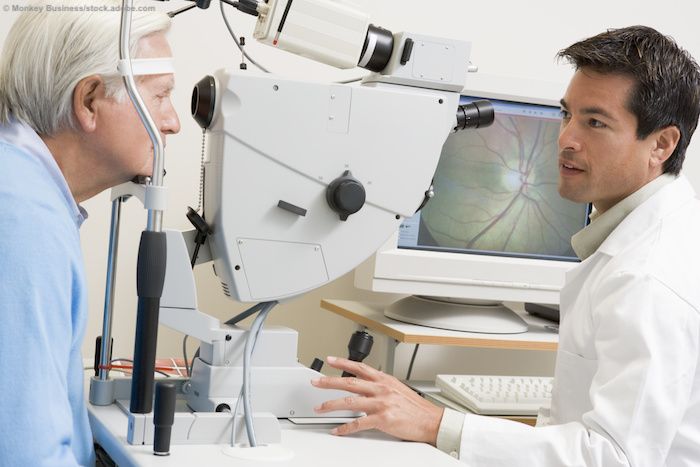Article
Therapeutic option improves outflow through trabecular meshwork
Author(s):
Exploring broad utility of netarsudil for ROCK inhibition across spectrum of glaucoma

Based on his experience and depending on the glaucoma patient, Gagan Sawhney, MD, explains why he considers netarsudil to be a valuable first- or second-line agent, as well as an effective addition to maximum medical therapy.
Despite significant progress in the fight against glaucoma, the human cost of this disease remains unacceptably high. According to the World Health Organization, it is the second-leading cause of blindness worldwide.
Though we’ve managed to reduce the long-term probability of going blind in one eye from glaucoma from 25.8% to 13.5% in recent decades, a significant portion of patients still progress to blindness.1 As a glaucoma specialist who sees more than 60 patients/day, this is a terrifying statistic.
Unfortunately, glaucoma is still a leading cause of blindness even under our care. Why does glaucoma still present such a therapeutic challenge? First, it is underdiagnosed. We are missing early disease; once damage is done, it cannot be reversed. Second, when we do diagnose and begin to treat glaucoma, too often we are not reaching target pressures, or not setting them low enough to begin with.
Third, when we do treat adequately, lack of compliance often impedes outcomes. The need to take multiple therapies several times a day, as well as the topical and systemic adverse events (AEs) associated with those therapies, affect patients’ ability to take medications as prescribed. Though a variety of promising surgical options have been introduced, these procedures do not come without potential AEs.
Medical therapy landscape
For the past 20 years, we have relied on an armamentarium that includes prostaglandin analogs (PGAs), alpha-adrenergic receptor agonists (alpha-agonists), beta-adrenergic receptor antagonists (beta-blockers), and carbonic anhydrase inhibitors (CAIs). These therapies generally promote aqueous outflow via the uveoscleral pathway or decrease aqueous production at the level of the ciliary body.
What is astonishing is that even though the trabecular meshwork is primarily responsible for aqueous outflow and subsequently becomes dysfunctional in open-angle glaucoma, we have not had a therapy that primarily targets this pathway until now.
Approved by the FDA in December 2017, netarsudil ophthalmic solution 0.02% (Rhopressa, Aerie Pharmaceuticals) is the first in a class of glaucoma medications called Rho kinase (ROCK) inhibitors. ROCK activity inhibition is thought to prevent contraction of trabecular meshwork stress fibers and reduce resistance to aqueous humor outflow by disrupting actin-myosin contraction, decreasing extracellular matrix production and relaxing the tissue.
This glaucoma medication is the first to improve trabecular meshwork outflow through this unique mechanism of action (MOA). In addition to targeting the trabecular meshwork, evidence suggests that netarsudil also reduces aqueous production via norepinephrine transporter inhibition2 and lowers episcleral venous pressure by ROCK inhibition.3,4
Leading to the drug’s approval were three clinical trials-ROCKET 1, 2, and 4-which examined its safety and efficacy dosed q.d. compared with timolol b.i.d.
Pooled results demonstrated once-daily netarsudil to be non-inferior to twice-daily timolol in patients with baseline IOP below 25 mm Hg, producing a mean reduction of IOP at peak of up to 5 mm Hg. This effect was maintained through 12 months. Maximum efficacy results were achieved at week 1 with netarsudil, comparing favorably with PGAs, which typically take about 4 to 6 weeks to achieve maximal response.
Netarsudil consistently lowered IOP at the same level of mm of Hg regardless of the starting IOP, differing from timolol, which did not perform as well at lower IOPs but better at higher IOPs. This is important because 80% of U.S. glaucoma patients have IOPs that are less than or equal to 26 mm Hg at time of diagnosis.5 Because netarsudil reduces both perfusion pressure and episcleral venous pressure (EVP), it can maintain more consistent efficacy across a larger range of IOPs.
The most commonly observed ocular AE in the ROCKET trials was conjunctival hyperemia (reported in 53% of patients), which appeared after two weeks of treatment and either resolved or did not progress with continued dosing. Importantly, in the ROCKET trials, after a washout period and prior to starting treatment with netarsudil, there was a baseline hyperemia rate of 20% that was not factored out of this statistic.
In 9 out of 10 patients, hyperemia was either not reported or reported as mild. In my patient population, I am seeing a 30% hyperemia rate. Fortunately, the hyperemia is mild and mostly well tolerated. Other ocular AEs (~20%) included cornea verticillata, instillation site pain, and conjunctival hemorrhage. Conjunctival (petechial) hemorrhage was graded as mild in more than 90% of cases.
Cornea verticillata, likely a result of netarsudil-induced phospholipidosis, was mild and seen only under biomicroscopy, unlike cases often associated with amiodarone.
Most cases resolved or improved by the end of a noninterventional follow-up study and were not associated with any clinically meaningful impact on visual function. Netarsudil has no labeled systemic contraindications, and unlike beta-blockers and alpha-agonists, does not have any effect on blood pressure or heart rate.
Physician experience
When I first heard about netarsudil, I was cautiously optimistic about the potential utility of a therapeutic option that improves outflow through the trabecular meshwork. I was also encouraged by the potential to enhance compliance given its once-daily dosing and mild AE profile.
To date, I have written more than 150 netarsudil prescriptions for patients across the entire glaucoma disease spectrum, including primary-open angle glaucoma (POAG) and normal/low-tension glaucoma (NTG/LTG).
I began prescribing netarsudil as a second- or third-line adjunctive agent in mild to moderate disease. One of these patients, a 70-year-old female, presented with a history of mild POAG OD and moderate POAG OS with a Tmax of 30 mm Hg OD and 32 mm Hg OS that was progressing at current IOPs of 17 mm Hg OD and 16 mm Hg OS.
The patient was on a PGA q.h.s. OU and CAI b.i.d. OU. Humphrey visual field mean deviation OD was –2.35 and mean deviation OS was –11.24. I added netarsudil q.h.s. OU to the patient’s regimen. At her four-week, follow-up appointment, IOPs were 10 mm Hg OD and 11 mm Hg OS, thus achieving goal pressures.
Cases with more severe disease
I have also had success with netarsudil in patients with more severe disease. One severe POAG patient was referred to me after having undergone a failed trabeculectomy and subsequent bleb needling. The patient was on three agents and had an IOP of 36 mm Hg. I recommended tube shunt surgery, but the patient was unwilling to undergo an additional procedure.
As a compromise, I prescribed netarsudil, which brought the IOP to 17 mm Hg, allowing us to avoid surgery. While this response is not typical (as evidenced by the trials in which a mean IOP reduction of up to 5 mm Hg was observed), this patient is an example of a small number of those
I consider “hyper-responders” to netarsudil where IOP reduction is greater than what is demonstrated by the ROCKET studies.
I have also had positive experience with netarsudil in NTG. The Collaborative Normal Tension Glaucoma Study Group recommended a 30% reduction in IOP for NTG to effectively slow the rate of progressive visual field loss.6
Because of netarsudil’s ability to lower both perfusion pressure and EVP, I am more easily able to achieve this suggested reduction. I have historically added a PGA as first-line therapy and an alpha agonist as a second agent in the setting of NTG. I am now using netarsudil as a second agent consistently, and even as first-line agent to try and reduce IOP with a single drop.
I was referred a 52-year-old male with moderate LTG who had a starting IOP of 17 mm Hg with moderate field loss.
On a PGA, the patient’s IOP was lowered to 15 mm Hg, and fields were continuing to progress. The patient poorly tolerated the prostaglandin secondary to prostaglandin associated periorbitopathy. I discontinued the prostaglandin and started netarsudil, which brought his IOP to 9 mm Hg.
Summary
Netarsudil addresses some of the most important issues associated with IOP-lowering therapies. Its MOA offers consistent IOP lowering regardless of baseline pressure or number of currently prescribed drops, and its q.d. dosing helps with compliance. It has a favorable safety profile, with minimal systemic AEs, no contraindications, and a generally tolerable ocular safety profile (in clinical studies, 53% of patients reported conjunctival hyperemia).
Discussing potential side effects, such as hyperemia, with patients in advance of prescribing can help allay undue concerns and allow ample time to make an informed decision about continuation of therapy together based on efficacy and tolerability.
Coverage for this medication is expanding rapidly but obtaining a prior authorization will help avoid frustration for patients and office staff. Based on my experience and depending on the patient, I consider netarsudil a valuable firstor second-line agent, as well as an effective addition to maximum medical therapy. I believe netarsudil can be used across the entire spectrum of glaucoma, from mild to severe disease in patients who are taking 0–1 drops to maximum medical therapy.
Disclosures:

Gagan Sawhney, MD
E: gsawhney@gmail.com
Dr. Sawhney is a speaker for Aerie Pharmaceuticals.
References:
1. Malihi M, Moura Filho ER, Hodge DO, Sit AJ. Long-term trends in glaucoma-related blindness in Olmsted County, Minnesota. Ophthalmology. 2013;121:134–141.
2. Serle, JB, Katz LJ, McLaurin E, Heah T, RamirezDavis N, Usner DW, Novack GD, Kopczynski CC. Two phase 3 clinical trials comparing the safety and efficacy of netarsudil to timolol in patients with elevated intraocular pressure: Rho kinase elevated IOP treatment Trial 1 and 2 (ROCKET-1 and ROCKET-2). Am J Ophthalmol. 2018;186:116–127.
3. Kiel JW, Kopczynski CC. Effect of AR-13324 on episcleral venous pressure in Dutch belted rabbits. J Ocul Pharmacol Ther. 2015;31:146–151.
4. Kazemi A, McLaren JW, Kopczynski C, Heah TG, Novack GD, Sit AJ. The effects of netarsudil ophthalmic solution on aqueous humor dynamics in a randomized study in humans. J of Ocul Pharmacol Ther. 2018;34:380–386.
5. Sommer A, Tielsch JM, Katz J et al. Relationship between intraocular pressure and primary open angle glaucoma among white and black Americans: The Baltimore Eye Survey. Arch Ophthalmol. 1991;109:1090–1095.
6. Collaborative Normal-Tension Glaucoma Study Group. The effectiveness of intraocular pressure reduction in the treatment of normal-tension glaucoma. Am J Ophthalmol. 1998;126:498-505.




